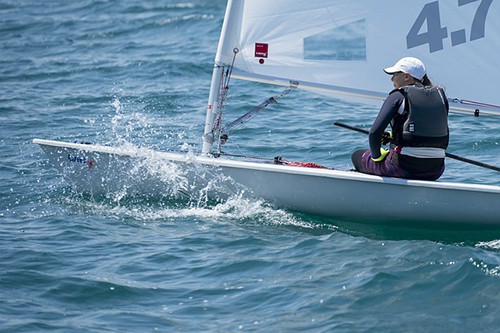
Originally Posted By: Laser Sailing Tips
Knowing what to wear sailing in the summer takes a bit of thought and preparation. You can’t just grab the first few things you see and head out on your way. Plus, the type of sailing you intend to do will have an impact on your clothing choices.
In this article, we will cover the basics of what you should wear and have with you on any sailing day during the summer months as well as cover some of the differences of what to wear when dinghy sailing compared to other types of boats.
HOW DIFFERENT TYPES OF SAILING IMPACTS CLOTHING CHOICE
What to wear when sailing at any time of year, not just in the summer months, depends a lot on what type of sailing you plan to do. For example, you will be more exposed to the water if you are sailing in a dinghy.
In summer, even on warm days and especially if it is windy, it can still get quite cool on the water when you are dinghy sailing. This means that you may need to wear a wetsuit and spray jacket, as well as booties with non-slip soles, even in the warmer months.
However, if you are going to enjoy some keelboat sailing, you may be comfortable in a t-shirt and shorts, and take along a rain jacket, just in case. Non-slip, closed-toe footwear is also a good choice.
So what you wear sailing in summer heavily depends on what type of boat you will be sailing on.
SAILING CLOTHING – WHAT TO WEAR SAILING IN THE SUMMER
Now that you have a rough outline of what you may need to wear depending on the type of sailing you are doing, let’s drill a little deeper into the specific types of sailing gear to take with you.
SAILING SHIRTS & TOPS
Ultraviolet light protection is a major factor when choosing the correct sailing clothing. Not only will you be exposed to the rays of the sun when outdoors, but those rays will also be reflected back at you off the water.
You can keep yourself protected by wearing tops and shirts that have a UPF rating of 50+. Be sure to pack both long-sleeved and short sleeve options so you can change to stay comfortable while sailing. A good collar on your shirt can also provide extra protection for your neck.
This isn’t as important when dinghy sailing (see below), however, you still need a good sailing shirtwhen rigging up on the shore.
VESTS/LIGHT JACKETS
On windy days in summer, you can stay warm with either a light jacket or a windbreaker. Many people find lined, sleeveless vests a good option. This gives you the greatest mobility while engaged in various tasks.
SAILING SHORTS & PANTS
You can’t just wear any kind of shorts or pants while sailing. Shorts that are specifically designed for sailing are a popular choice. The difference is that a proper pair of sailing pants or shorts can take a lot of abuse on board your sailing boat. This includes rubbing against things that could rip ordinary pants. Sailing pants and shorts also have UPF protection and have wicking material to keep you dry, as well as pockets for storage.
When dinghy sailing, some people like to wear shorts over the top of their wetsuit to protect their wetsuit from wear, especially in the seat area. Some shorts also have extra padding in the back to make it more comfortable.
Other people prefer to wear long-legged pants to protect them from the sun, as your thighs, in particular, can get easily sunburned.
SAILING HATS
When wondering what to wear sailing in the summer, an important area is to protect your head, including your face, ears, and neck. This makes a good sailing hat essential. They come in various styles and feature such extras as lightweight, breathable construction, UPF protection, brims to protect your eyes, sweatbands, and hat clips to keep them from getting blown away. Some are also waterproof and contain wicking materials and venting holes to keep your head dry and cool
SAILING WATCH
Regardless of the time of year, it’s a good idea to wear a sailing watch, especially if you are racing. When the countdown to the start is underway, you need to know exactly how long you have got before the start so you can position yourself in the best spot without breaking the line. Check out our picks of some of the best sailing watches here.
EYEWEAR
In addition to protecting your eyes from the glare of the sun, eyewear will also keep your eyes safe from the wind. This means sunglasses of some kind but be sure to choose a pair that provides adequate coverage of your eyes and has a high UPF value.
If you wear prescription glasses, there are many options available including clip-on shades and styles that will fit over your current prescription frames.
Dinghy sailing with sunglasses can be a bit of a challenge since you may capsize. So, if you want to wear sunnies on the water, make sure you have a sunglasses strap to keep them secure.
SAILING SHOES
Not only will you want to have comfortable footwear, but the shoes also have to be safe. Sandals and open-toe footwear can be packed, but are best left in your sailing gear bag until you get ashore.
While sailing, you should be wearing a pair of good sailing shoes that will give you solid footing on wet surfaces and are lightweight and breathable to keep your feet from sweating in socks.
Traditional shoes and boots don’t work too well when dingy sailing, so sailing booties are best to protect your feet, keep them warm, prevent sunburn, and give you the best grip. They are shorter than traditional boots and often also have a Velcro strap to keep them secure.
SAILING GLOVES
Sailing gloves are not just used to keep your hands warm. When sailing, they are used all year round to also protect them from rope burn and the elements.
Because sailing is going to involve close contact with ropes and other sailing gear, you will want to have a good quality pair of sailing gloves in your pack of sailing clothes.
You may find a pair of short-finger gloves to your liking but be sure to find a pair that has good padding and protection in the palm and fingers, and velcro fasteners to keep them on snugly and can be removed quickly.
Some also have a cut-out on the top of the wrist so that you can easily access the buttons and see the screen on your watch.
SUNSCREEN
Again, since you will be in the sun for the majority of the time you spend on the water, sunscreen is going to be the secret weapon that will give you that extra layer of protection. This is even more important when you are wearing shorts and short-sleeved shirts.
Always choose a sunscreen with the highest UPF value you can find and apply it liberally.
It is so important to protect your skin from sun damage. When sailing in the summer months, you can get sunburnt extremely quickly, so take extra care. You can also get sunburnt in winter, so protection all year round is important.
LIFE JACKET/WET SUIT
A comfortable, well-fitting Coast Guard-approved life jacket is a must for any sailor who spends time boating. They are a necessity to wear when dinghy sailing. You want a life jacket that does not restrict your movement too much.
A wetsuit is generally not worn when on yachts. However, when dinghy sailing, because you are wet quite a lot of the time, and especially if there is a breeze, you can get cold quickly, even when sailing in the summer months. So, you need something that will keep your core warm but also not restrict movement.
There are different types, styles, and thicknesses of wetsuits that will suit your sailing requirements. For example, you may choose a 2mm sort leg/arm with a rash vest to protect from the sun for summer, and a 3mm long leg/arm for the cooler months.
IN CONCLUSION
When figuring out what to wear sailing in the summer months, you have to consider the type of sailing you will be doing. It is also important to remember that as warm as it may be in summer, there is still a chance that you are still going to get wet, which may mean you will get cold on the water.
Your sailing clothing must be able to withstand the rigors of the sport, protect you from the elements, allow you to move around the boat, and still keep you comfortable. So, when considering what to wear sailing in the summer, be prepared and use the points above as a starting point, and enjoy your day out on the water.
